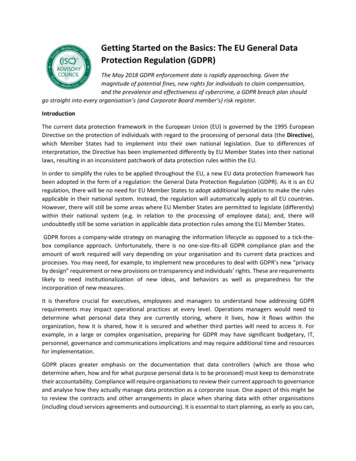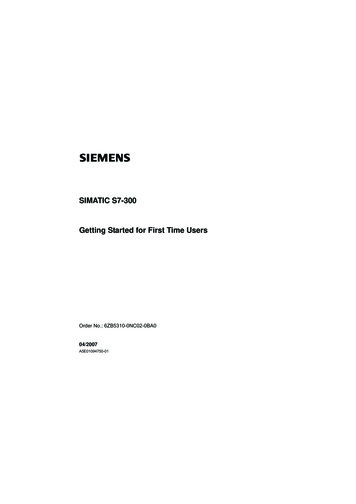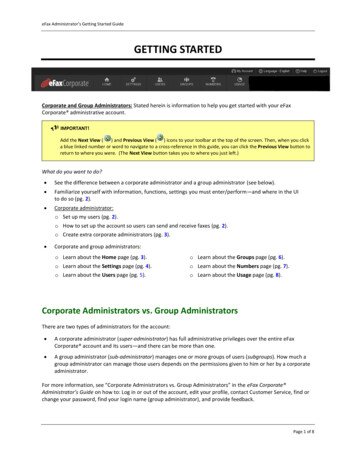
Transcription
Getting Started on the Basics: The EU General DataProtection Regulation (GDPR)The May 2018 GDPR enforcement date is rapidly approaching. Given themagnitude of potential fines, new rights for individuals to claim compensation,and the prevalence and effectiveness of cybercrime, a GDPR breach plan shouldgo straight into every organisation’s (and Corporate Board member’s) risk register.IntroductionThe current data protection framework in the European Union (EU) is governed by the 1995 EuropeanDirective on the protection of individuals with regard to the processing of personal data (the Directive),which Member States had to implement into their own national legislation. Due to differences ofinterpretation, the Directive has been implemented differently by EU Member States into their nationallaws, resulting in an inconsistent patchwork of data protection rules within the EU.In order to simplify the rules to be applied throughout the EU, a new EU data protection framework hasbeen adopted in the form of a regulation: the General Data Protection Regulation (GDPR). As it is an EUregulation, there will be no need for EU Member States to adopt additional legislation to make the rulesapplicable in their national system. Instead, the regulation will automatically apply to all EU countries.However, there will still be some areas where EU Member States are permitted to legislate (differently)within their national system (e.g. in relation to the processing of employee data); and, there willundoubtedly still be some variation in applicable data protection rules among the EU Member States.GDPR forces a company-wide strategy on managing the information lifecycle as opposed to a tick-thebox compliance approach. Unfortunately, there is no one-size-fits-all GDPR compliance plan and theamount of work required will vary depending on your organisation and its current data practices andprocesses. You may need, for example, to implement new procedures to deal with GDPR’s new “privacyby design” requirement or new provisions on transparency and individuals’ rights. These are requirementslikely to need institutionalization of new ideas, and behaviors as well as preparedness for theincorporation of new measures.It is therefore crucial for executives, employees and managers to understand how addressing GDPRrequirements may impact operational practices at every level. Operations managers would need todetermine what personal data they are currently storing, where it lives, how it flows within theorganization, how it is shared, how it is secured and whether third parties will need to access it. Forexample, in a large or complex organisation, preparing for GDPR may have significant budgetary, IT,personnel, governance and communications implications and may require additional time and resourcesfor implementation.GDPR places greater emphasis on the documentation that data controllers (which are those whodetermine when, how and for what purpose personal data is to be processed) must keep to demonstratetheir accountability. Compliance will require organisations to review their current approach to governanceand analyse how they actually manage data protection as a corporate issue. One aspect of this might beto review the contracts and other arrangements in place when sharing data with other organisations(including cloud services agreements and outsourcing). It is essential to start planning, as early as you can,
and to gain ‘buy-in’ from key stakeholders in your organisation. Here we offer an overview of the keyareas to be addressed to help them understand the task ahead.The Basic Considerations for all Organisations The penalties for violations have become much more severe.Under the current data protection framework, the Directive left to the EU Member States thediscretion to decide the maximum level of fines to be imposed. This resulted in strong discrepanciesbetween the EU Member States: fines may amount to EUR 25,000 in Austria, EUR 150,000 in France,EUR 600,000 in Spain or 500,000 in the United Kingdom. In a number of matters involving privacyviolations, data protection authorities (DPAs) had little recourse against large, well-fundedmultinationals who could be tempted to view such fines as merely the “cost of doing business”.Under Article 83(5) of t GDPR, DPAs would be able to impose fines of up to 20M or 4% of theoffending company’s total worldwide annual turnover of the preceding financial year, whichever ishigher.In addition, individuals may also seek to enforce their data protection rights: Article 82(1) of the GDPRprovides that any person having suffered material or non-material damages as a result of theprocessing of his personal data may claim for compensation. The definition of what is considered “personal data” has increased in scopeUnder GDPR, the definition of “personal data” will cover a wider range of data types. Article 4(1)provides that:'personal data' means any information relating to an identified or identifiable natural person('data subject'); an identifiable natural person is one who can be identified, directly orindirectly, in particular by reference to an identifier such as a name, an identification number,location data, an online identifier or to one or more factors specific to the physical,physiological, genetic, mental, economic, cultural or social identity of that natural person.It has been made clear within GDPR (recital 30) that IP addresses, cookie identifiers, mobile device IDand other types of online identifiers are deemed to be “personal data” and must be protectedaccordingly. GDPR has a wider geographical scopeArticle 3 of the GDPR provides that the new rules apply to entities established in the EU and theEconomic Exclusive Zone (EEZ) that are processing personal data either for their own purposes (as“data controllers”) or on behalf of another entity (as “data processors”), regardless of whether theprocessing of data actually takes place in the EU or not. Shipping vessels that work within the EEZ areincluded for example. In addition, Article 3(2) further provides that GDPR will apply worldwide to anyprocessing of personal data of individuals who are in the EU, whenever such processing is related tothe offering of goods or services (including those that are free) to individuals in the EU, or where thebehaviour of EU individuals is monitored.In practical terms, this means that any company that does business with EU residents (e.g. marketingof goods or services) will be subject to GDPR, even if they operate outside of the EU and do not have
any premises or equipment in the EU. Anyone operating a website accessible from the EU (whichcould be considered the provision of a free electronic service) may be subject to GDPR, and asdescribed in the above point, the collection of IP addresses in access logs, or the tracking of visitorsusing cookies, JavaScript or other tracking technologies would trigger the application of GDPR. A data processing register is mandatoryArticle 30(1) of GDPR requires data controllers and processors to maintain a written record (whichmay be in electronic form) of processing activities under its responsibility, while Article 30(4) furtherprovides that such record must be available to the relevant DPA upon request.The record must include the following: the name and contact details of the controller and, where applicable, the joint controller, thecontroller's representative and the data protection officer;the purposes of the processing;a description of the categories of data subjects and of the categories of personal data;the categories of recipients to whom the personal data have been or will be disclosedincluding recipients in third countries or international organisations;where applicable, transfers of personal data to a third country or an internationalorganisation, including the identification of that third country or international organisationand the documentation of suitable safeguards;where possible, the envisaged time limits for erasure of the different categories of data;where possible, a general description of the technical and organisational security measuresin place to safeguard the data.If the above requirements are not met, Article 83 (4) of GDPR provides that an administrative fine ofup to EUR 10 Million or 2% of the total worldwide annual turnover of the preceding financial year,whichever is higher.The regulation states that the record requirement does not apply to small organisations (less than 250people, however we can expect many small and medium size organisations will be required tomaintain and keep the records if: the processing is likely to result in a risk to the rights of affected employees (e.g. scoring,comprehensive monitoring, high risk resulting out of unauthorized disclosure or access, useof new technologies);the processing is not occasional; orthe processing includes special categories of data as outlined in Article 9 (1) (e.g. health data,biometric data, data related to political or philosophical beliefs) or personal data relating tocriminal convictions and offences referred to in Article 10 of GDPR.New user rights have to be implementedAs detailed in Articles 13-22, organisations will need to ensure that effective systems andprocesses are in place to give effect to the following rights:1. The right to be informed2. The right of access
3. The right to rectification4. The right to erasure (the 'right to be forgotten')5. The right to restrict processing6. The right to data portability7. The right to object8. Rights in relation to automated decision making and profiling.Organisations will need, for example, to have a policy in place to determine when certain data is nolonger necessary to retain; for how individuals will be able to withdraw their consent; and to dealwith user requests when they object to the processing of their data.Given how often enterprise data is simply archived rather than deleted and the sheer volume of suchdata, removing irrelevant personal data on request is undoubtedly going to be a big challenge. Serverand device logging, which can capture a substantial amount of personal data by itself, will likely be atarget for erasure requests. Technical and organisational [security] measures are mandatoryGDPR requires data “controllers” (which are those who determine when, how and for what purposepersonal data is to be processed) to “implement appropriate technical and organizational measures”to protect the personal data that they hold and the risks that are presented in the processing of thedata, “in particular from accidental or unlawful destruction, loss, alteration, unauthorised disclosureof, or access to personal data transmitted, stored or otherwise processed.”Article 32 also provides certain examples of the security measures expected: the pseudonymisation (e.g. hashing) and encryption of personal data,the ability to ensure the ongoing confidentiality, integrity, availability and resilience ofprocessing systems and services;the ability to restore the availability and access to personal data in a timely manner in theevent of a physical or technical incident;a process for regularly testing, assessing and evaluating the effectiveness of technical andorganisational measures for ensuring the security of the processing.Data protection impact assessments are now requiredData protection must now be designed into systems by default and privacy impact assessments (PIAs)– or what the GDPR calls data protection impact assessments (DPIAs) – are now mandatory (Article35) for technologies and processes that are likely to result in a high risk to the rights of individuals(e.g. profiling leading to decisions that produce legal effects for the individual or processing on a largescale). The DPA may list specific situations for which a DPIA is or is not required, while mostorganisations should, as part of their privacy-by-design and default strategies, ensure that a DPIA isnow part of their risk assessment process. Personal data breaches must be reported
It will become mandatory (Article 33 of the GDPR) for an organisation to report any data breach to itsDPA within 72 hours of becoming aware of it. If that requirement is not met, the eventual report mustbe accompanied by an explanation for the delay. The notification must follow a specific format, whichincludes a requirement to describe the measures being taken to address the breach and mitigate itspossible side effects.Where the breach may result in a high risk to the rights and freedoms of individuals, they must becontacted “without undue delay after becoming aware of” the data breach. This communication willnot be necessary if appropriate protective measures – such as encryption – are in place to eliminateany danger to the affected individuals. A Data Protection Officer is required for certain organisationsIn certain circumstances, an organisation may be required to designate a Data Protection Officer (theDPO), i.e. where the “core activities” of the organisation involve the monitoring of individuals on alarge scale or where there is a large scale processing of “special categories of data” (e.g. an individual’sracial or ethnic origin, political opinions, religious or philosophical beliefs, trade-union membership,genetic data, biometric data if processed in order to uniquely identify a natural person, health, sex lifeor sexual orientation).SummaryWhile the GDPR is not yet applicable, its enforcement date is rapidly approaching and it is necessary touse the remaining time left to prepare for the new requirements. The scope of the requirements isbroad: GDPR forces a company-wide strategy and review of processes for managing personal data onevery level, and it includes various types of online data in its definition of personal. New rights andobligations must be accounted for and every organisation will have to work out its own approach toreflect the context and practices of the business. It is crucial that the management of the GDPRcompliance plan becomes a top priority on the agendas of the board and top management.This document was prepared by members of the (ISC)2 EMEA Advisory Council GDPR Task Force. Lead Contributors:Yves Le Roux, CISSP, CISM; Paul Lanois, CCSK, CIPM, CIPT, CIPP (A, E, US and C), FIP, CISMP and LLM.Reviewed by Dr. Adrian Davis, MBA, FBCS CITP, CISSP; Sam Berger, CISSP; Michael Christensen, CISSP, CSSLP, CISM,CRISC, CIS LI, EU-GDPR-P; CCM, CCSK, CPSA, ISTQB, PRINCE2, ITIL, COBIT5; Ramon Codina, CISSP; Santosh KrishnaPutchala, CISSP
3. The right to rectification 4. The right to erasure (the 'right to be forgotten') 5. The right to restrict processing 6. The right to data portability











